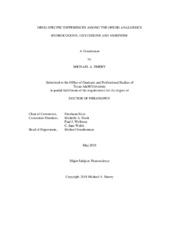| dc.description.abstract | Opioids have been utilized for millennia for analgesia, but are accompanied by numerous adverse effects in addition to their pain relief abilities. These include tolerance, opioid-induced hyperalgesia, the propensity for abuse, and discrepancies regarding their ability to treat chronic pain. Despite efforts to find non-opioid alternatives, opioids remain the gold standard in spite of their drawbacks. Historically, both prescription and research of opioids have been guided by the assumption that analgesic properties and adverse associated effects are mediated by the same mechanisms and therefore are inseparable. Relatively recent discoveries regarding ligand-directed signaling at the opioid receptors have called this assumption into question, indicating that similar opioid analgesics may exhibit drug-specific differences in antinociceptive function and adverse effects. The current work investigated this hypothesis by examining three commonly prescribed and abused opioids, oxycodone, hydrocodone and morphine, for drug-specific differences in their antinociceptive potency and ability to prevent injury-induced hyperalgesia, their behavioral effects on the reward-related D2 signaling system, and molecular & gene expression changes.
First, a mouse burn-injury model was developed that produced significant nociception which worsened across 28 days. Then, using this model, opioids were examined for drug-specific differences in their antinociceptive potency to treat burn pain, their ability to prevent/treat injury-induced long-term hyperalgesia, and correlations between antinociceptive potency and hyperalgesia prevention.
iii
It was found that burn injury pain per se reduced the antinociceptive potency of opioids, but no drug-specific differences existed in potency. However, drug-specific differences did exist in the ability to prevent hyperalgesia development. When examined on the individual level, it was found that greater early pain relief led to reduced long-term pain outcomes.
In addition, drug-specific differences were shown to exist in the ability to increase behavioral sensitivity of the D2DR system in both the absence and presence of burn pain, to alter intracellular signaling in both the absence and presence of D2DR agonism, and to alter gene expression levels.
These findings provide evidence of wide-spread drug-specific differences between common opioid analgesics that can carry clinically relevant implications for pain treatment, chronic pain outcomes, addiction, and other long-term outcomes resulting from opioid exposure. | en |


